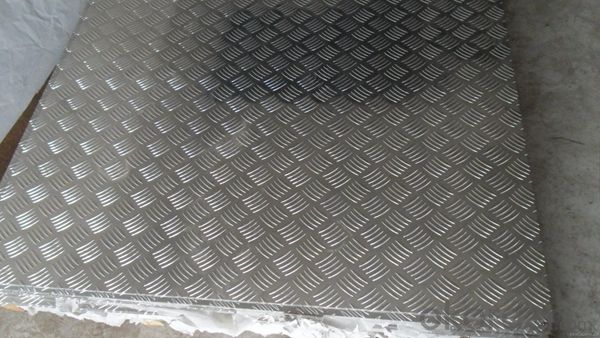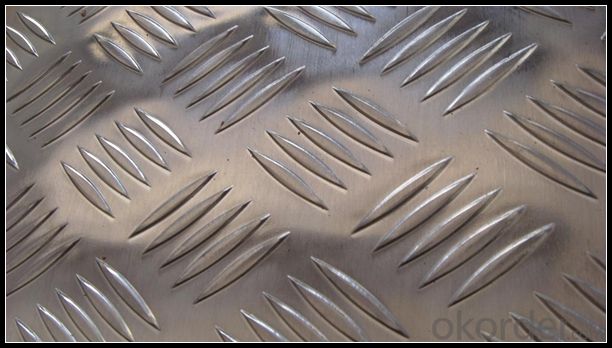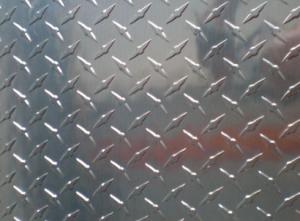Home Depot Checkered Treadplate Aluminium Panel 3003 H22 Sheets of Aluminum
- Loading Port:
- Shanghai
- Payment Terms:
- TT OR LC
- Min Order Qty:
- 5 m.t.
- Supply Capability:
- 10000 m.t./month
OKorder Service Pledge
OKorder Financial Service
You Might Also Like
Specification
1. Specification of Checkered Treadplate Aluminium Panel 3003 H22
Alloy Number | AA1XXX,AA3XXX,AA5XXX |
Temper | H12, H14, H16, H18, H22, H24, H26, H32, HO, F |
Thickness | 0.1mm – 500mm |
Width | 10mm- 2200mm |
Standard | GB/T3880-2006, ASTM, ISO, EU standard |
2. Application of Checkered Treadplate Aluminium Panel 3003 H22
Transfporation, vehicle, antiskid plate,toolbox,canopy body,
3. Feature of Checkered Treadplate Aluminium Panel 3003 H22
Surfact Quality :
Be free from Oil Stain, Dent, Inclusion, Scratches, Stain, Oxide Dicoloration, Breaks, Corrosion, Roll Marks, Dirt Streaks and other defect which will interfere with use,
Mechenical Property:
Chemical Composite and Mechanical Property
4. Certificate:
SGS and ROHS(if client request, paid by client), MTC(plant provided), Certificate of Origin(FORM A, FORM E, CO), Bureau Veritas and SGS (if client request, paid by client), CIQS certificate
5. Image of Five Bar Treadplate Aluminium Panel 3003 H22 for Tool Box




6. Package and shipping of Checkered Treadplate Aluminium Panel 3003 H22
First, plastic cloth with drying agent inside; Second, Pearl Wool ; Third, wooden cases with dry agent , fumigation wooden pallets, aluminum surface could cover blue PVC film
7. FAQ
1) What is the delivery time?
Dpends on actual order, around 20 to 35 days
2)What is the QC system:
We have QC staff of 20 persons and advanced equipment, each production is with MTC traced from Aluminum ingot lot.
3) What market do you mainly sell to?
Australia, America, Asia, Middle East, Western Europe, Africa etc
- Q: How is the strength and durability of aluminum sheets determined?
- The determination of the strength and durability of aluminum sheets involves the utilization of various testing methods and parameters. A key factor in establishing the strength of these sheets is their alloy composition. Different compositions of alloys possess different levels of strength, and the addition of certain elements to the aluminum can enhance its strength properties. In order to assess the strength of aluminum sheets, the commonly employed method is tensile testing. This procedure entails subjecting a sample of the sheet to tension until it fractures. Throughout the test, the load and deformation are measured, and the ultimate tensile strength (UTS) and yield strength are established. The UTS signifies the maximum amount of stress that the sheet can endure before failure, whereas the yield strength is the stress at which the material begins to deform plastically. The thickness of aluminum sheets is another crucial consideration when determining their strength and durability. Generally, thicker sheets tend to exhibit greater strength and durability compared to thinner ones due to the increased cross-sectional area that contributes to their load-bearing capacity. Apart from alloy composition and thickness, the strength and durability of aluminum sheets are also influenced by the manufacturing process. Factors such as rolling and heat treatment have the ability to alter the microstructure of the aluminum, thereby affecting its mechanical properties. Effective control of these processes is essential in order to ensure consistent strength and durability across all sheets. Moreover, the resistance to corrosion is often evaluated for aluminum sheets. Aluminum naturally forms a protective oxide layer, which enhances its resistance to corrosion. However, specific coatings or treatments can be applied to further enhance this resistance, depending on the intended application. In conclusion, the determination of the strength and durability of aluminum sheets is achieved through a combination of factors including alloy composition, thickness, manufacturing processes, and testing methods such as tensile testing. These factors collectively govern the mechanical properties and resistance of aluminum sheets to various forms of stress, rendering them suitable for a wide array of applications.
- Q: How is aluminum sheet made?
- Aluminum sheet is made through a process called rolling, where a large aluminum ingot is passed through a series of rollers that gradually reduce the thickness of the metal until it reaches the desired sheet thickness. This process helps to improve the strength, flexibility, and surface finish of the aluminum sheet.
- Q: What is the thickness of the aluminum sheets?
- The thickness of the aluminum sheets varies depending on the specific product or application.
- Q: What are the dimensions of 101 aluminum sheets?
- The dimensions of 101 aluminum sheets can vary depending on the specific requirements or specifications. Generally, aluminum sheets come in standard sizes and thicknesses, such as 4 feet by 8 feet or 3 feet by 10 feet, with thicknesses ranging from 0.02 inches to 0.25 inches. It is important to note that custom sizes and thicknesses can also be obtained based on individual needs and preferences.
- Q: or aluminum ? and what other gases are released?
- Aluminium does not normally react with water because of a surface coating of the highly unreactive Al2O3 that forms on exposure to atmospheric oxygen. In the presence of strong base, however, this compound dissolves due to complexation by hydroxide, similarly to how silver chloride dissolves in ammonia. Al2O3(s) + 2OH-(aq) + 3H2O(l) ----- 2[Al(OH)4]-(aq) Once this has occured, aluminium metal, a very strong reducing agent, is exposed to water. 2Al(s) + 6H+(aq) ----- 2Al3+(aq) + 3H2(g) Even though the solution is alkaline, there is still a low concentration of H+ formed by the autoprotolytic dissociation of water. The Al3+ formed then reacts with hydroxide to produce more [Al(OH)4]-. Yes, the hydrogen gas is from the water.
- Q: Can the aluminum sheets be used for manufacturing aircraft engine components?
- Yes, aluminum sheets can be used for manufacturing aircraft engine components due to their lightweight, high strength, and good corrosion resistance properties.
- Q: 1100 scope of application of aluminum plate
- 1100 aluminum plate is generally used in utensils, heat sink, caps, printing plates, building materials, heat exchanger components, but also can be used as deep stamping products. It is widely used in various fields ranging from cooking utensils to industrial equipment
- Q: Are aluminum sheets suitable for outdoor signage?
- Yes, aluminum sheets are suitable for outdoor signage. They are durable, weather-resistant, and can withstand various environmental conditions such as rain, wind, and sunlight. Additionally, aluminum sheets can be easily customized, making them ideal for outdoor signage applications.
- Q: What are the common thicknesses of aluminum sheets used in aerospace applications?
- In aerospace applications, aluminum sheets are commonly used due to their lightweight and high strength properties. The thickness of aluminum sheets used in aerospace applications can vary depending on the specific requirements of the component or structure being fabricated. Commonly used thicknesses for aluminum sheets in aerospace applications range from 0.016 inches (0.4 mm) to 0.25 inches (6.35 mm). These thicknesses are selected based on factors such as the desired strength-to-weight ratio, structural integrity, and the specific application or component being manufactured. Thinner aluminum sheets, such as those with a thickness of 0.016 to 0.040 inches, are often used for lightweight structures, interior components, and non-critical parts. These thinner sheets provide the necessary strength while minimizing weight. For more structural components, thicker aluminum sheets are employed. Thicknesses between 0.040 and 0.125 inches are commonly used for structural elements like floor panels, bulkheads, and wing ribs. These sheets offer increased strength and rigidity for supporting the aircraft's weight and managing the stresses experienced during flight. In certain cases, even thicker aluminum sheets may be used, ranging from 0.125 to 0.25 inches, for heavy-duty structural components or areas where additional strength is required. These thicker sheets are utilized in critical parts such as landing gear components, wing spars, and engine mounts to ensure the necessary structural integrity and load-bearing capability. It is important to note that these are general ranges, and the specific thickness requirements may vary depending on the aircraft type, design specifications, and the particular application within the aerospace industry.
- Q: This question asks for a list of various types of fasteners that can be used to secure aluminum windows to their frames.
- <p>There are several types of fasteners used for attaching aluminum windows to frames, including: 1. Screws: Commonly used for their secure hold and ease of installation. 2. Nails: Quick to use but may not provide the same level of security as screws. 3. Adhesives: Can be used for a more permanent bond, especially in certain applications. 4. Clips and brackets: Used for a more visible, decorative attachment. 5. Rivets: Provide a strong, permanent connection but are not easily removable. 6. Dowels and pins: Used for a more traditional or decorative join. 7. Structural glazing systems: Employ silicone or other sealants to bond the window to the frame. Each type of fastener has its own advantages and is chosen based on the specific requirements of the project, such as load-bearing needs, aesthetic considerations, and the desired level of permanence.</p>
Send your message to us
Home Depot Checkered Treadplate Aluminium Panel 3003 H22 Sheets of Aluminum
- Loading Port:
- Shanghai
- Payment Terms:
- TT OR LC
- Min Order Qty:
- 5 m.t.
- Supply Capability:
- 10000 m.t./month
OKorder Service Pledge
OKorder Financial Service
Similar products
Hot products
Hot Searches
Related keywords


























